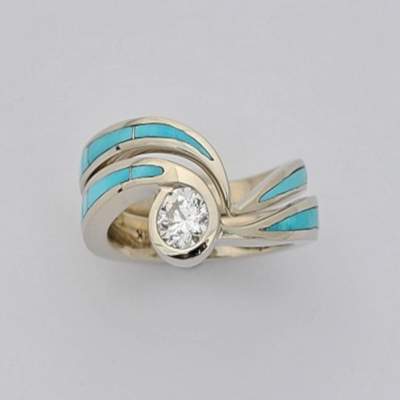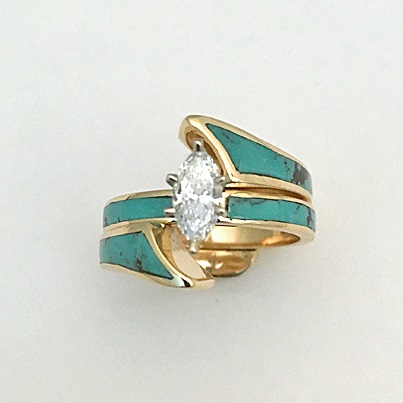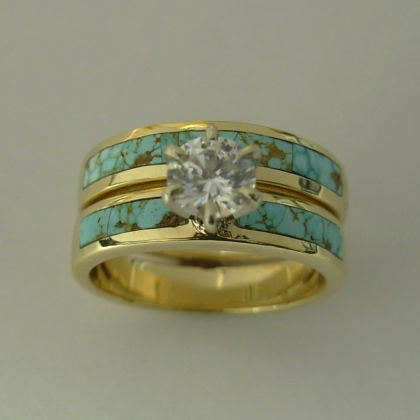Since it is commonplace and traditional to consider the diamond as the only valuable gemstone one should set in the center of an engagement ring, it is hard to envision anything else. However, traditions are sometimes meant to broken, so considering a different stone than a diamond as the center stone for an engagement ring will open your world to multiple beautiful breathtaking possibilities to a different center stone instead. For the adventuresome looking for a unique and stunning engagement ring, turquoise delivers the goods so to speak. Additionally, a turquoise and diamond engagement ring provides an even bigger splash when it comes to spectacular engagement rings.
Turquoise Defined
Turquoise is a dense mineral that occurs in nature. Its color varies and it ranges from brilliant deep blue to subtle dark green in color. It is hydrated phosphate composed of copper and aluminum. It is extremely rare, and it is considered a high-value gemstone in its finder grades. It has been treasured by owners and jewelers alike as an ornamental stone and gemstone for 100’s of centuries, due mostly to its unusual blue and green tones and brilliance when cut and highly polished. Turquoise, like several dense gemstones, has had it value reduced by different turquoise copies and replacements including synthetics, and imitation turquoise.
Turquoise is particularly treasured and famous for its stunning colors. It comes from copper deposits and colors of this gemstone come in a wide variety of green and blue shades. Robin’s egg blue color normally brings the highest price for turquoise.
Turquoise Throughout History
Turquoise as a gemstone historically is referenced several thousand years ago. There were ancient Egyptian tombs discovered by archeologists with turquoise jewelry found in the treasures. The tomb dated back around 5,000 years ago. These days turquoise is still mined in U.S. in the Southwest region, China, and Iran. The name turquoise comes from the words ‘pierre tourques’, which in French means, Turkish stone. Some believe turquoise originated somewhere in Turkey.
Turquoise Rings Are Treasures—Here’s Why
The mineral turquoise is often found in arid geographical locations with copper laced water tables. It is rare to find it, so when large deposits of turquoise are located, it is considered most likely to the owner of the mine, a financial bonanza. Turquoise is usually worth a lot because like most gemstones, the market for the mineral is finite, so values remain high. When the levels of copper are high, the turquoise color tends to be very blue. Occasionally turquoise is discover with a spiderweb veins matrix, instead of one solid blue or green color.
Out of all the gemstone cuts turquoise can be formed into, the most popular is a cabochon. Turquoise is amenable when it comes to carving, cutting and use in inlay because on the Mohs scaled it sits around 5, which means as a gemstone it is relatively soft. It is easy to damage through scratching or cracking, which is a disadvantage.
The Gemology Institute of America ranks turquoise for three important ranking components, matrix or no matrix, the turquoise’s color richness and tone and its overall texture. When it comes to jewelry, the main cost is the cost of turquoise itself, the custom jewelers’ design of the piece, the metal used, the amount of metal required to make it, and the manufacturing of the piece. Engagement rings today featuring turquoise also incorporate several other rare gems and intricate designs. One of the most popular engagement rings being offered today by custom jewelers is a turquoise and diamond engagement ring. In most instances the diamond is featured as the center stone and turquoise is quite often incorporated into the design using inlay features.
Make Your Turquoise Ring Last—Here’s How
Follow the care recommendations for your turquoise ring from the custom jeweler that designed and manufactured it. The key to not harming it is to use the following tips which are as follows; do not expose it to extreme heat, such as leaving it in a hot car; do not clean it with strong chemical treatments or extremely hot water; and do not wash your hands with hand sanitizer while your ring is on because the chemicals in it will dissolve the inlay setting material. From there any inlay turquoise will fall out, ruining the ring.

14 Karat Gold Wedding Set
Materials: Ladies 14 karat gold two ring set. The center is the engagement ring and the outer is the wedding band which is joined on the bottom of the ring. This set is designed for a Marquise cut center stone. The inlay in this set is Turquoise. (other materials are available for inlay) .. The ring is show in a size 6.
Artist: Patrick Barnes
Price: The Engagement Ring without the Center Stone (mounting only) is $900. The Wedding Band / Ring Guard is $1650.00
#SWE0006
See this described ring just below.

14 Karat Yellow Gold Wedding Set With Turquoise and Diamond
Materials: 14 karat yellow Gold engagement ring and wedding band. The engagement ring is approx. 4 mm wide and is show with a 1/2 carat round head set center stone. The wedding band is also approx. 4 mm wide. They both feature Natural Turquoise from Nevada. They are shown in a size 6.
Artist: Patrick Barnes
Price: Engagement ring with head but without center Diamond $990.00. Wedding band $900.00
#SWE0005
See the this described ring just below.

